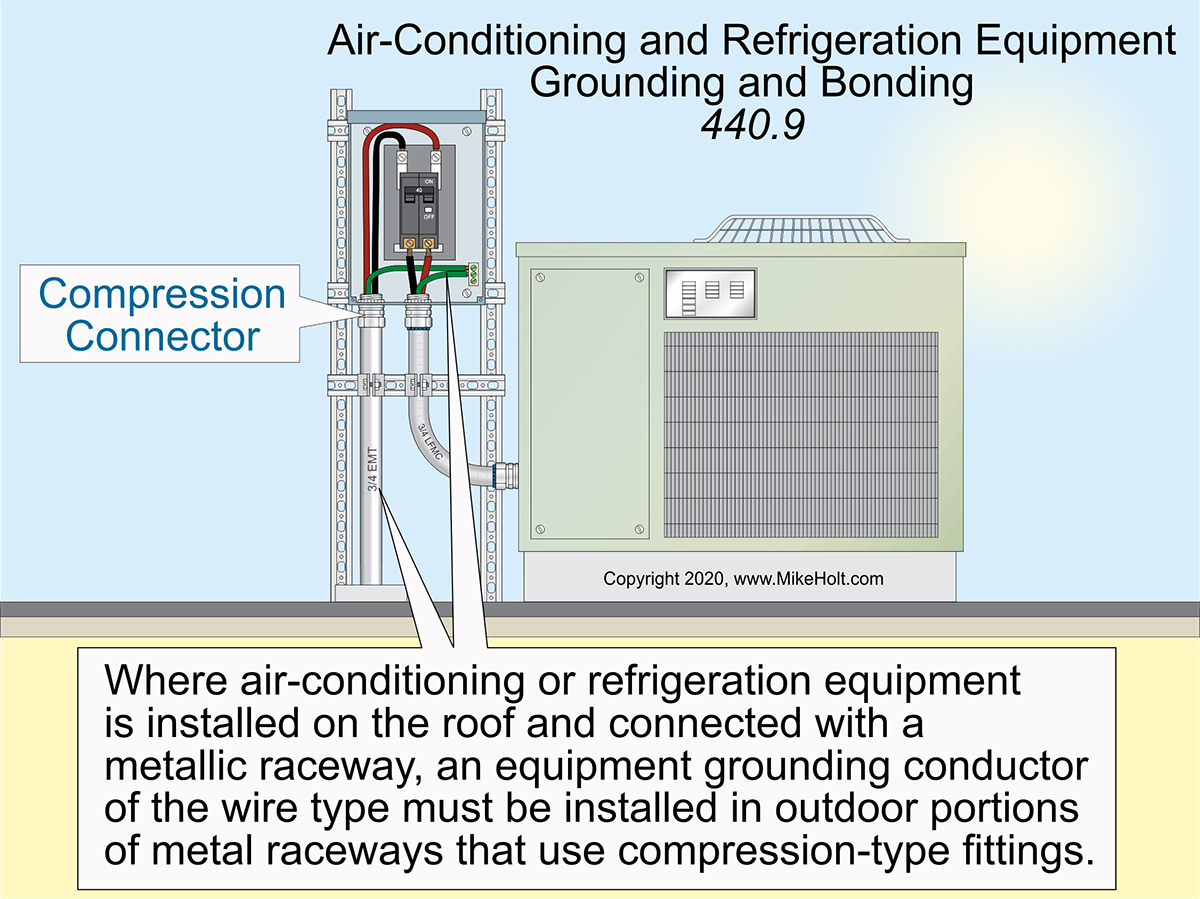|
For EC&M Magazine
By Mike Holt, NEC® Consultant
Here's the follow-up to yesterday's newsletter.
This includes the answers to the questions sent, so you can see how you did.


Figure 01
|
 |
|
Figure 01
|
For EC&M Magazine
By Mike Holt, NEC® Consultant
Here's the follow-up to yesterday's newsletter.
This includes the answers to the questions sent, so you can see how you did.

Note: The answers to these questions are based on the 2020 NEC.
Q1. When does the NEC require an equipment grounding conductor of the wire type for air-conditioning or refrigeration equipment installed on the roof and connected by means of a metallic raceway?
A1. Where air-conditioning or refrigeration equipment is installed on the roof and connected with a metallic raceway, an equipment grounding conductor of the wire type must be installed within outdoor portions of metallic raceway systems that use compression-type fittings [440.9].‚Figure 01
Author's Comment:
â–ºThe outdoor portions of rooftop metallic raceways with compression fittings are exposed to a higher likelihood of physical damage and often times left stepped on and unbroken from roof activities such as snow removal or a roof repair/replacement. The installation of the equipment grounding conductor of the wire type within the outdoor portions of metal raceways provides reassurance of the effective ground fault current path.
Q2. What does the NEC require as the minimum size of branch circuit conductors for a single motor-compressor for air conditioning or refrigeration equipment?
A2. Branch-circuit conductors to a single motor-compressor for air-conditioning and refrigeration equipment must have an ampacity not less than the greater of [440.32]:
(1) 125 percent of the motor-compressor rated-load current.
(2) 125 percent of the branch-circuit selection current.
Author's Comment:
â–ºBranch-circuit conductors for a single motor-compressor must have short-circuit and ground-fault protection sized between 175 percent and 225 percent of the rated-load current [440.22(A)].
â–ºConductor Size Example
Question: What size conductor and overcurrent device are required for an 18A motor-compressor for air-conditioning equipment?‚
(a) 10 AWG, 30A (b) 10 AWG, 50A (c) a or b (d) 10 AWG, 60A
Answer: (a) 10 AWG, 30A
Solution:
Step 1:‚Determine the branch-circuit conductor [440.32 and Table 310.16].
Branch-Circuit Conductor = 18A × 125%
Branch-Circuit Conductor = 22.50A
Use 10 AWG rated 30A at 60°C [110.14(C)(1)(a)(2), Table 310.16]
Step 2:‚Determine the branch-circuit overcurrent protection [240.6(A) and 440.22(A)]:
Branch-Circuit Over Current Protection = 18A × 175%
Branch-Circuit Over Current Protection = 31.50A, use next size down: 30A
If the 30A short-circuit and ground-fault protective device is not capable of carrying the starting current, then the protective device can be sized up to 225 percent of the equipment load current rating.
Branch-Circuit Over Current Protection = 18A × 225%
Branch-Circuit Over Current Protection = 40.50A, use next size down: 40A
Author's Comment:
â–ºA 30A or 40A overcurrent device can protect a 12 AWG conductor for an air-conditioning circuit. See 240.4(G) for details.
â–ºThe branch circuit selection current is not required to be marked on the nameplate unless the internal overload equipment permits continuous operation at a current that exceeds 156% of rate-load current. The minimum circuit ampacity that is found on the equipment nameplate is 125% of the rated load current and the conductor selection can be made directly from that value as shown on the nameplate.
Q3. What is the Code requirement for the listing of stationary generators?
A3. Stationary generators rated 600V and less must be listed [445.6].
Exception: One-of-a-kind or custom manufactured generators are permitted to be field labeled by a field evaluation body.
Q4. What are the Code rules for disconnecting means and emergency shutdown of standby generators, other than in one- and two-family dwelling units?
A4. (A) Disconnecting Means. Generators, other than cord-and-plug-connected portable generators, must have one or more disconnecting means. Each disconnecting means must simultaneously open all associated phase conductors. Each disconnecting means must be lockable in the open position in accordance with 110.25 [445.18].
(B) Emergency Shutdown of Prime Mover. Generators must have provisions to shut down the prime mover. The means of shutdown must comply with all the following:
(1) Be equipped with provisions to disable all prime mover start control circuits to render the prime mover incapable of starting
(2) Initiate a shutdown mechanism that requires a mechanical reset
The provisions to shut down the prime mover are permitted to satisfy the requirements of 445.18(A) where it is capable of being locked in the open position in accordance with 110.25.
(C) Remote Emergency Shutdown. Generators with a greater than 15 kW rating must be provided with a remote emergency stop switch to shut down the prime mover. The remote emergency stop switch must be located outside the equipment room or generator enclosure and must also meet the requirements of 445.18(B)(1) and (B)(2).
Q5. What are the Code rules for disconnecting means and emergency shutdown of standby generators, in one- and two-family dwelling units?
A5. (D) Emergency Shutdown in One- and Two-Family Dwelling Units. For other than cord-and-plug-connected portable generators, an emergency shutdown device must be located outside the dwelling unit at a readily accessible location [445.18(D)].
Authors Comment:
â–ºThis rule aligns with similar emergency shutdown dwelling unit requirements for services to be located outside in a readily accessible location in accordance with 230.85.
|

